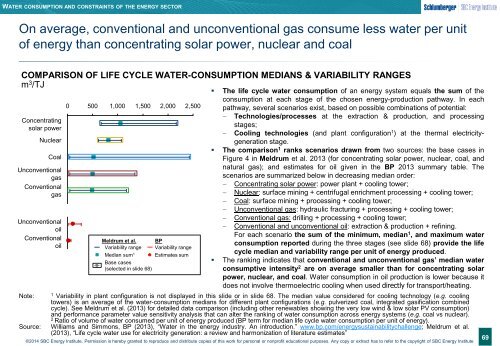1wMF53w
1wMF53w
1wMF53w
You also want an ePaper? Increase the reach of your titles
YUMPU automatically turns print PDFs into web optimized ePapers that Google loves.
WATER CONSUMPTION AND CONSTRAINTS OF THE ENERGY SECTOR<br />
On average, conventional and unconventional gas consume less water per unit<br />
of energy than concentrating solar power, nuclear and coal<br />
COMPARISON OF LIFE CYCLE WATER-CONSUMPTION MEDIANS & VARIABILITY RANGES<br />
m 3 /TJ<br />
• The life cycle water consumption of an energy system equals the sum of the<br />
Concentrating<br />
solar power<br />
Note:<br />
Source:<br />
Nuclear<br />
Coal<br />
Unconventional<br />
gas<br />
Conventional<br />
gas<br />
Unconventional<br />
oil<br />
Conventional<br />
oil<br />
0 500 1,000 1,500 2,000 2,500<br />
Variability range<br />
Meldrum et al.<br />
Median sum 1<br />
Base cases<br />
(selected in slide 68)<br />
BP<br />
Variability range<br />
Estimates sum<br />
consumption at each stage of the chosen energy-production pathway. In each<br />
pathway, several scenarios exist, based on possible combinations of potential:<br />
Technologies/processes at the extraction & production, and processing<br />
stages;<br />
Cooling technologies (and plant configuration 1 ) at the thermal electricitygeneration<br />
stage.<br />
• The comparison 1 ranks scenarios drawn from two sources: the base cases in<br />
Figure 4 in Meldrum et al. 2013 (for concentrating solar power, nuclear, coal, and<br />
natural gas); and estimates for oil given in the BP 2013 summary table. The<br />
scenarios are summarized below in decreasing median order:<br />
<br />
<br />
<br />
<br />
<br />
<br />
Concentrating solar power: power plant + cooling tower;<br />
Nuclear: surface mining + centrifugal enrichment processing + cooling tower;<br />
Coal: surface mining + processing + cooling tower;<br />
Unconventional gas: hydraulic fracturing + processing + cooling tower;<br />
Conventional gas: drilling + processing + cooling tower;<br />
Conventional and unconventional oil: extraction & production + refining.<br />
For each scenario the sum of the minimum, median 1 , and maximum water<br />
consumption reported during the three stages (see slide 68) provide the life<br />
cycle median and variability range per unit of energy produced.<br />
• The ranking indicates that conventional and unconventional gas’ median water<br />
consumptive intensity 2 are on average smaller than for concentrating solar<br />
power, nuclear, and coal. Water consumption in oil production is lower because it<br />
does not involve thermoelectric cooling when used directly for transport/heating.<br />
1<br />
Variability in plant configuration is not displayed in this slide or in slide 68. The median value considered for cooling technology (e.g. cooling<br />
towers) is an average of the water-consumption medians for different plant configurations (e.g. pulverized coal, integrated gasification combined<br />
cycle). See Meldrum et al. (2013) for detailed data comparison (including other renewables showing the very low wind & low solar PV consumption)<br />
and performance parameter value sensitivity analysis that can alter the ranking of water consumption across energy systems (e.g. coal vs nuclear).<br />
2<br />
Ratio of volume of water consumed per unit of energy produced (BP term for median life cycle water consumption per unit of energy).<br />
Williams and Simmons, BP (2013), “Water in the energy industry. An introduction.” www.bp.com/energysustainabilitychallenge; Meldrum et al.<br />
(2013), “Life cycle water use for electricity generation: a review and harmonization of literature estimates”<br />
69<br />
©2014 SBC Energy Institute. Permission is hereby granted to reproduce and distribute copies of this work for personal or nonprofit educational purposes. Any copy or extract has to refer to the copyright of SBC Energy Institute<br />
69


